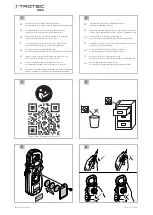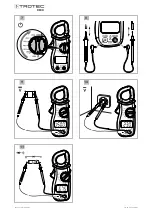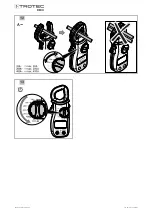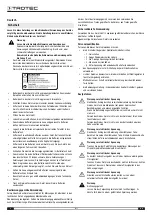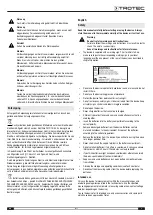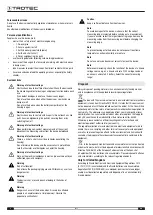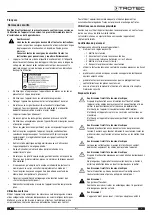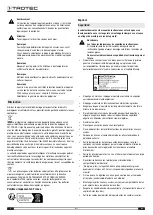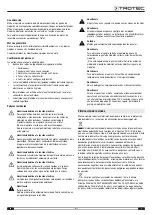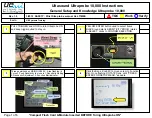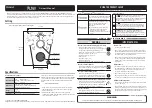
6
EN
BE38
Foreseeable misuse
Do not use the device in potentially explosive atmospheres, when wet or very
humid.
Unauthorized modifications of the device are forbidden.
Personnel qualifications
People who use this device must:
•
master the 5 safety rules of electrical engineering
– 1. De-energise
– 2. Secure against restart
– 3. Verify de-energised state (bipolar)
– 4. Earth and short-circuit
– 5. Cover neighbouring live parts
•
use the voltage detector following safe working procedures.
•
be aware of the dangers that occur when working with electric devices
in damp areas.
•
take measures to protect themselves from direct contact with live parts.
•
have read and understood the operating manual, especially the Safety
chapter.
Residual risks
Warning of electrical voltage
Electric shock due to insufficient insulation! Check the device and
the measuring cables for damages and proper function before each
use.
If you detect damages, do not use the device any longer.
Do not use the device when either the device or your hands are
damp or wet!
Do not use the device when the battery compartment or the
housing is open.
Warning of electrical voltage
Electric shock due to contact with live parts! Do not touch any live
parts. Secure neighbouring live parts by covering them or by
switching them off.
Warning of electrical voltage
When performing non-contact measurements of the current,
disconnect the measuring cables from the device beforehand.
Warning of electrical voltage
There is a risk of a short-circuit due to liquids penetrating the
housing!
Do not immerse the device and the accessories in water. Make
sure that no water or other liquids can enter the housing.
Warning of electrical voltage
Work on the electrical components must only be carried out by an
authorised specialist company!
Warning
Risk of suffocation!
Do not leave the packaging lying around. Children may use it as a
dangerous toy.
Warning
The device is not a toy and does not belong in the hands of
children.
Warning
Dangers can occur at the device when it is used by untrained
people in an unprofessional or improper way! Observe the
personnel qualifications!
Caution
Keep a sufficient distance from heat sources.
Note
To avoid damages to the device, make sure that the correct
measuring range is selected before carrying out a measurement.
If you are unsure, select the largest measuring range. Remove the
measuring cables from the measuring point before changing the
measuring range.
Note
To prevent damages to the device, do not expose it to extreme
temperatures, extreme humidity or moisture.
Note
Do not use abrasive cleaners or solvents to clean the device.
Note
Before commissioning, check the function of the device at a known
voltage source, e.g. on a known and safe 230 V voltage source or
on a known and safe 9 V battery. Select the correct measuring
range!
Disposal
Always dispose of packing materials in an environmentally friendly manner
and in accordance with the applicable local disposal regulations.
The icon with the crossed-out waste bin on waste electrical or electronic
equipment is taken from Directive 2012/19/EU. It states that this device must
not be disposed of with the household waste at the end of its life. You will find
collection points for free return of waste electrical and electronic equipment in
your vicinity. The addresses can be obtained from your municipality or local
administration. You can also find out about other return options that apply for
many EU countries on the website https://hub.trotec.com/?id=45090.
Otherwise, please contact an official recycling centre for electronic and
electrical equipment authorised for your country.
The separate collection of waste electrical and electronic equipment aims to
enable the re-use, recycling and other forms of recovery of waste equipment
as well as to prevent negative effects for the environment and human health
caused by the disposal of hazardous substances potentially contained in the
equipment.
In the European Union, batteries and accumulators must not be treated
as domestic waste, but must be disposed of professionally in accordance with
Directive 2006/66/EC of the European Parliament and of the Council of
6 September 2006 on batteries and accumulators. Please dispose of batteries
and accumulators according to the relevant legal requirements.
Only for United Kingdom
According to Waste Electrical and Electronic Equipment Regulations 2013
(SI 2013/3113) (as amended) and the Waste Batteries and Accumulators
Regulations 2009 (SI 2009/890) (as amended), devices that are no longer
usable must be collected separately and disposed of in an environmentally
friendly manner.

